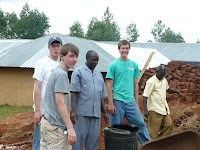A little while ago, Jason was able to take some students to a small village and help build some homes. They worked with Habitat for Humanity in a small village near Kisii. It is about 7 hours away from Nairobi (near Lake Victoria). The drive was beautiful. Kenya really is one of the most beautiful countries. We drove through the very dry Rift Valley (no moisture anywhere, cattle and people barely surviving), then through an incredibly forest, then up into the mountains covered with tea fields that were brilliant shades of green. Kisii experiences rain almost everyday year round. Kisii is full of agriculture (much of Kenya's tea and sugar comes from this region).
The team slept on the floor of a local school and ate in an unused classroom. The boys' room had a very uneven dirt floor (35 feels older than it sounds after a night on the hard ground!). We had a roof over our heads that kept out most of the rain, rafters full of wasps (fortunately we had mosquito nets), and a small family of rats that kept us company at night. The girls' room was much newer and had a nice smooth concrete floor - hard but at least even. All of us were serenaded at night by goats, cows, dogs, crickets and roosters.
We ate our meals in an unfinished classroom and ate at school desks. The desks were very primitive boards nailed together. It was a great opportunity to eat regular Kenyan meals. Lots of beans and rice (my favorite), meat stews (goat and chicken), chapatis, potatoes and cabbage at every meal, and matake stew (banana stew) cooked in a peanut flavored sauce. Breakfast was very simple white bread with Blue Band and red plum jelly, hard boiled eggs, and loads of fresh bananas and mangoes.
There was no electricity anywhere in the village. The night sky was beautiful up in the mountains. For 10 shillings, they will charge your cell phone at a little shop with a small generator (great business opportunity). At night we used a couple of kerosene lanterns to eat by. The school had put up four "shower" areas. They consisted of small branches holding up plastic grain sacks. Inside there was a large bucket you could fill with warm water to take a sponge bath. Down the center of each stall was a shallow trench for you to pour the used water in. (I enjoyed being at the top of the hill more than the bottom). A couple of innovative village children climbed one of the nearby trees to see what we were doing behind the tarps. Needless to say there was a lot of laughter! The school also dug us two brand new long-drop toilets. It was very much appreciated. (New means no smell).
The local people were wonderful. Incredibly friendly, even though there was a language barrier - smiles work everywhere. Actually, many Kenyans are tri-lingual, speaking English, Kiswahili, and a tribal language. Our village was very remote, and most of the adults spoke only Kisii (which is a city, a county, a tribal group, and a language). The people there were incredibly poor, yet very happy. Most of the community lived in huts with walls made out of a mixture of mud and manure. I had the great honor of eating with the village chief in his home. He became a great friend, and we spent a lot of time together.
We helped build two homes in the village. The people were very skeptical of our skinny white girls especially, but we all earned their respect with our hard work and great attitudes. The students I got to work with were wonderful. Each year students from Rosslyn Academy go on a CFS (Cultural Field Studies) trip to learn more about Kenyan culture. It was a great experience that I will never forget.
Here are a few pictures. The students in our group; some of the village after a church service; two pictures at the work site (in one I am standing next to the chief); and a picture of the students who let us sleep in their classrooms.


















